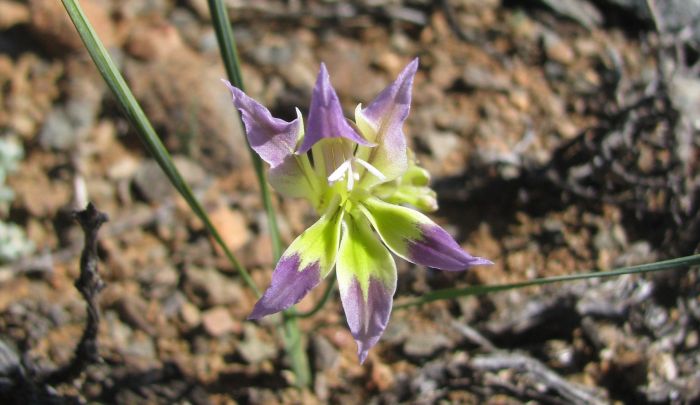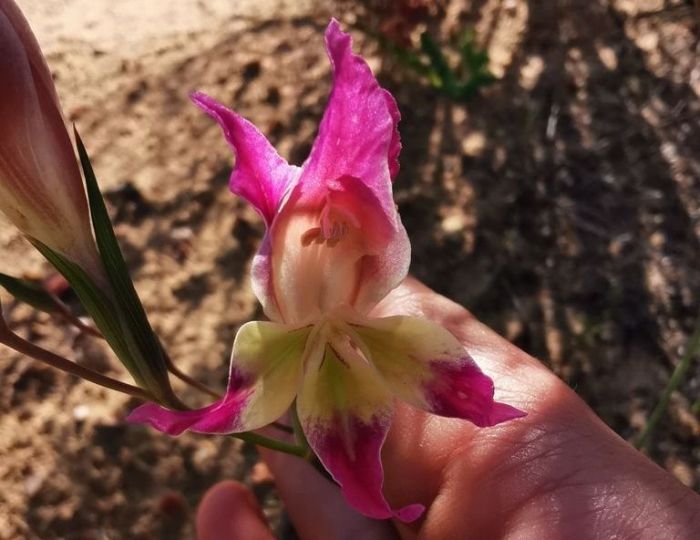Gladiolus venustus
Gladiolus venustus G.J.Lewis
Family: Iridaceae
Common names: bright bonnet, purple kalkoentjie (Eng.); kalkoentjie, perskalkoentjie, haasblom, perdelelie, bontpatryspypie (Afr.)
Introduction
Gladiolus venustus is a showy species, with fragrant, purple or pink and yellow flowers in spring, best suited for the arid regions of the winter-rainfall area, or containers.

Description
Description
Bright bonnets is a cormous geophyte, 120–350 mm high, with 5 or 6 linear leaves that have a lightly raised midrib. Flowers are sweetly scented and are borne on a 5–8-flowered spike; each flower with 2 mauve to purple or deep pink upper tepals and 3 lower tepals marked with a band of greenish yellow. It flowers in early spring, from August to October in the southern hemisphere. The fruit is a 3-locular capsule containing numerous, fairly large, light brown, broadly winged seeds.

Conservation Status
Status
This species is assessed as Least Concern (LC) according to SANBI’s Red List of South African plants. The population is stable and is not endangered.
Distribution and habitat
Distribution description
Gladiolus venustus has a wide distribution across the interior of the southern African winter-rainfall region. The species is found in arid habitats and occurs from Swellendam northwards to Nieuwoudtville, on clay and shale substrates, but it is sometimes found on dry, stony, sandstone hillsides.

Derivation of name and historical aspects
History
The genus name Gladiolus comes from the Latin gladius, meaning ‘small sword’, referring to the shape of the leaves. The specific epithet venustus is named in honour of Venus the ancient Roman goddess of beauty and love, referring to the attractive, often beautifully coloured flowers. The common name bright bonnet is given to the shape of the striking, 2-toned flowers that give the appearance of a hat.
There are 260 species of Gladiolus of which 28 occur in the Klein Karoo and 15 occur in Namaqualand. Gladiolus is the second largest genus of the family Iridaceae, after Iris.
Gladiolus venustus was not described earlier than 1864 when F.W. Klatt named it Gladiolus formosus. When the early collectors encountered the species they confused it with others, like G. orchidiflorus and G. virescens. C.F. Ecklon regarded it as a distinct species, which he associated with Gladiolus formosus described by Persoon in 1805. There was uncertainty on the identity of Persoon’s species, but, as he associated it with G. striatus Jacquin, a species of Babiana, Persoon’s G. formosus is deemed to be unlawful and redundant. In 1941 G.J. Lewis applied the new name, Gladiolus venustus for the species. Later Amelia Obermeyer (Lewis et al. 1972) concluded that G. venustus and G. scullyi were the same species (conspecific) and she united them under the latter name. In 1998, Goldblatt & Manning re-instated the species, G. venustus, regarding G. venustus and G. scullyi as 2 separate species, although they are closely related. It is more difficult to see the distinctions between them on herbarium specimens (when dry) than when alive and identification is complicated. A difference between them is that Gladiolus scullyi has gently arched lower tepals and those of G. venustus are pinched and sharply bent downwards.
Other noteworthy members of the genus are Gladiolus alatus (kalkoentjie) with its attractive orange flowers, the lower tepals greenish yellow tipped orange, G. carinatus (blue afrikaner) with its elegant, funnel-shaped flowers in shades of mauve, have yellow markings on the lower tepals, G. gracilis (sandpypie) with its striking pale blue flowers with purple and yellow streaks on the lower tepals and the taller growing floriferous, G. orchidiflorus (groen kalkoentjie) with its enchanting hanging, pale greenish grey flowers, the lower tepals marked with a transverse band of yellow is desirable.
Ecology
Ecology
A variety of long tongued-bees, mostly belonging to Anthophoridae, are attracted to the fairly large flowers of Gladiolus venustus, with nectar guides on the upper third of the tepals, which they visit and pollinate. These insects being the primary pollinators of this species. An additional attractant to these bees is the sweet fragrance of the flowers, so they visit the fairly long perianth tube that appears to contain nectar which they forage for. The dry slightly inflated capsules, may act as sails, floating the dry, dead stems and allowing the whole aerial part of the plant to be dispersed as a unit, by wind, rather than the seeds alone.
Baboons, porcupines, molerats and other rodents, and guinea-fowl are major predators of the corms, thus annually reducing the population numbers of mature plants. For many species of Gladiolus, molerats are important dispersal agents. Corms and bulbs are collected in huge numbers by these animals; they store these food reserves in their underground burrows. Mature undamaged corms can, in this way, be carried over large distances. One can even find that uneaten corms will grow the following season in a new site. This accidental spreading of cormlets along the underground runs is due to the forgotten corms in molerat stores (Goldblatt et al. 2020).

Uses
Use
This plant has economic potential as a garden ornamental and is best suited for containers or for a sunny rock garden. No medicinal value has been recorded. These plants are also water-wise. Plants are not sold in nurseries but seed is available and can be ordered from nurseries online via the internet.

Growing Gladiolus venustus
Grow
Asexual propagation of gladioli by means of seeds is an easy, inexpensive way of increasing stocks. Sow the seeds in autumn in deep seed trays in a well-drained growing medium of 2 parts river sand, 1 part loam and 1 part well-decomposed compost. Sprinkle the seeds evenly over the surface, avoid overcrowding and cover them with a thin layer of river sand and water well with a mist sprayer.
Depending on the species, fresh seeds germinate within 3 to 6 weeks. Since Gladiolus venustus is summer deciduous, the species should be dried off during this period. Leave the young plants in the seed trays for at least 2 years, where they can grow on. Then the seedling can then be potted-up individually into pots before the winter growing period. The seedlings of most species will flower in their third year (Du Plessis & Duncan 1989).
Because of the short lifespan of many winter growers, it is essential to cross pollinate the flowers and sow fresh seeds every year, to ensure that material at different stages of development is at hand should the corms perish.
The corms are planted in autumn and depending on size, at a depth of 2–5 cm. Initially a heavy drench is applied in autumn. The corms must be kept completely dry in summer in the dormant season. Most plants that grow from corms will produce cormlets that can be removed from the mother plant when they are big enough and grown separately. Corms can be stored in a dry place until the next planting season.
Companion plants that are suitable to place with Gladiolus venustus in a rock garden are: Aptosimum procumbens (Karoo-violet) with its mat forming growth habit, smooth spoon-shaped leaves and its violet blue flowers with a white throat; Crassula deltoidea (katakiso) with its woody basal branches, smooth bright yellowish green leaves with a clear red edge and white flowers; Crassula ovata (jade plant) with its bonsai-like appearance and white to light pink flowers; Drosanthemum speciosum (Worcester vygie) with its jelly bean-like leaves and stunning crimson red flowers in spring; Eriocephalus africanus (wild rosemary) with its silver-grey, woolly leaves; Euphorbia mauritanica (geelmelkbos), with its much-branched, cylindrical, grey-green stems and small yellow flowers; Senecio haworthii (snow daisy) with its cylindrical white leaves, soft felt-like texture and yellow disc florets and Tulista maxima (vratjiesaalwyn) a stemless leaf succulent with white knobs and warts on the upper and lower surfaces.
The corms of all of the winter growers are highly susceptible to mealy bug infestation and fungal rotting caused mainly by Botrytis and Fusarium. Treat mealy bug by using 1:1 methylated spirits diluted in water. Apply with an earbud on the affected area. The alcohol will help to dissolve the waxy coat of the mealy bug, thus killing them. Aphids attack the developing flower buds. Ladybird larvae will naturally feed on aphids reducing their numbers.
References
- Duncan, G. 2010. Grow bulbs. A guide to the cultivation of bulbs of South Africa and neighboring countries. Kirstenbosch Gardening Series. South African National Biodiversity Institute, Cape Town.
- Goldblatt, P. & Manning, J. 1998. Gladiolus in southern Africa. Fernwood Press, Vlaeberg.
- Goldblatt, P. & Manning, J.C. 2020. Iridaceae of southern Africa. Strelitzia 42. South African National Biodiversity Institute, Pretoria.
- Manning, J., Goldblatt, P. & Snijman, D. 2002. The color encyclopedia of Cape bulbs. Timber Press, Cambridge.
- Vlok, J. & Schutte-Vlok, A-L. 2015. Plants of the Klein Karoo. Umdaus Press, Hatfield.
- Foden, W. & Potter, L. 2005. Gladiolus venustus G.J.Lewis. National Assessment: Red List of South African plants version 2020.1. Accessed on 2020/11/30.
- Pacific Bulb Society, Gladiolus venustus https://www.pacificbulbsociety.org/pbswiki/index.php/Gladiolus_venustus. Accessed 05/01/2021.
- Gardening Know How, Gladiolus Seed Pods: Harvesting Gladiolus Seeds for Planting. https://www.gardeningknowhow.com/ornamental/bulbs/gladiola/gladiolus-seed-pods.htm. Accessed 12/01/2021.
Credits
Shireen Harris
Karoo Desert National Botanical Garden
February 2021
Acknowledgements: the author thanks Annerie Senekal, Andrew Thompson and Lize Labuscagne for allowing the use of their images.
Plant Attributes:
Plant Type: Bulb
SA Distribution: Northern Cape, Western Cape
Soil type: Sandy, Clay
Flowering season: Spring
PH: Acid
Flower colour: Purple, Pink, Yellow, Mauve/Lilac
Aspect: Full Sun
Gardening skill: Average
Special Features:
Horticultural zones








Rate this article
Article well written and informative
Rate this plant
Is this an interesting plant?
Login to add your Comment
Back to topNot registered yet? Click here to register.